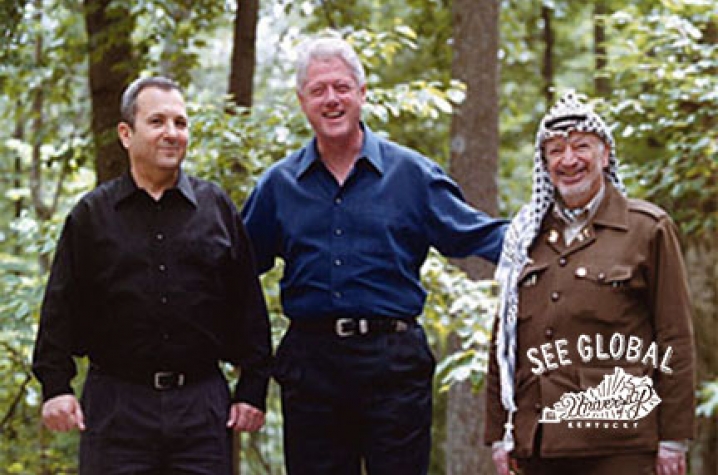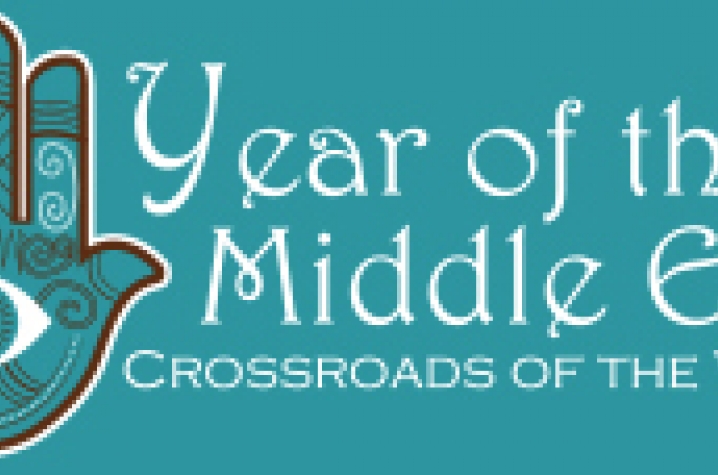The Middle East: Crossroads of the World
LEXINGTON, Ky. (Aug. 29, 2014) — The University of Kentucky College of Arts and Sciences’ Passport to the World program has already whisked students on four virtual globetrotting tours, yearlong explorations into the culture and history of a country or region. For the program’s fifth academic year, the college will delve into the turbulent, headline-grabbing region of the Middle East.
Once again the UK College of Arts and Sciences has chosen a region that impacts all of us. The eyes of the world have focused on the area for months, years. And yet, for many Americans, the Middle East is still mysterious and threatening, a culture and people churning with unfamiliar beliefs, traditions, expectations and dreams.
Like past programs about South Africa, China, Russia and Mexico, Passport to the World’s 2014-15 program, Year of the Middle East: Crossroads of the World, will engage the campus community in crucial global conversations through public lectures, cultural events, coursework and travel opportunities.
For a podcast featuring the event's organizers, visit https://www.as.uky.edu/podcasts/get-your-passport-ready-professors-year-middle-east .
Although they come from different backgrounds, with different interests and fields of study, a common thread binds Crossroads of the World organizers, Janice W. Fernheimer and Paul Thomas Chamberlin. They both recognize the history, an Arab-Israeli conflict with American involvement that has become perennial and devastating.
While not ignoring the military conflict, “We wanted the Year of the Middle East program to push beyond the headlines and serve as an introduction for UK students and the Lexington community to the rich and diverse cultures and history of the region and its peoples,” said Chamberlin, an associate professor of history.
Fernheimer, an associate professor in the Department of Writing, Rhetoric and Digital Studies and director of Jewish Studies, was an undergraduate at the University of Maryland majoring in English when she was drawn to the Hebrew language.
“I had and continue to have a deep passion and love for languages and wanted to take my basic Hebrew literacy to a living level," Fernheimer said. "As an undergraduate, I began to study Hebrew language intensely and to develop a deeper awareness of the many complexities surrounding Israel and the region along with my increasing fluency in the language.”
Her desire to become fluent in Hebrew led her to apply for and receive a Dorot Fellowship, which enabled her to live in Israel during 2000-2001, a very tumultuous time. She arrived in the summer of 2000, shortly before the Camp David Summit between President Bill Clinton, Palestinian leader Yasser Arafat and Israeli leader Ehud Barak. Despite “a palpable feeling of excitement over the possibility for lasting peace,” the talks failed and the Second Intifada erupted.
“Those hopes were replaced by a very palpable fear as suicide bombings became part of the daily news, not only on TV and in the newspapers, but also part of my daily reality,” Fernheimer said. In spite of the conflict, that year she traveled widely throughout Israel and the region to Egypt, Jordan, Turkey and Greece, and has returned to the region time and time again.
Chamberlin’s personal interest in the Middle East began during his college years, as the United States embarked on the so-called Global War on Terror and prepared to re-invade Iraq. He began learning Arabic in graduate school and soon had the opportunity to study at the American University in Cairo and the University of Damascus.
“This meant that I was able to spend a considerable amount of time living in both Egypt and Syria, which allowed me to travel around the region,” Chamberlin said. It wasn’t long before he too was captivated by the region, its history and its people.
“The United States has, of course, become involved in multiple wars in the region in recent years, and the Arab-Israeli conflict is a topic of perennial interest,” said Chamberlin. But it has been the people, their rich history and their diverse cultures, that keep him enthralled.
Following are some of the Middle East: Crossroads of the World events scheduled for September. Check the Year of the Middle East calendar for events scheduled later in the fall semester. Unless otherwise designated, the entire campus (faculty, staff and students) is invited to attend.
Sept. 3 – Sepharad at the Tip of Africa – Vanessa Paloma ‒ a pre-kickoff event – Niles Gallery ‒ Noon-1 p.m.
The Jewish community of Morocco has benefited from the history of migrations across the Strait of Gibraltar. The influences of Africa, the Mediterranean and the Iberian Peninsula are represented in their music and poetry. Accompanying herself with a medieval harp and percussion, Paloma will perform Judeo-Spanish Romances, Judeo-Arabic piyyutim and Hebrew prayers rarely heard in public settings.
Vanessa Paloma -- Natasha's Bar and Bistro (off-campus, downtown) -- 8-9 p.m.
Free concert.
Sept. 4 ‒ Year of the Middle East Kickoff ‒ Vanessa Paloma ‒ Student Center lawn ‒ Noon-2 p.m.
A second chance to hear Vanessa Paloma perform.
Sept. 8 ‒ Kosher/Soul Presentation: Black-Jewish Identity Cooking ‒ Michael Twitty ‒ Martin Luther King Center, Student Center ‒ 7-8 p.m.
Twitty is a recognized culinary historian and independent scholar focusing on historic foods, folk culture and culinary traditions of historic regions.
Sept. 10 ‒ The Future of Islam – John Esposito -- Recital Hall, Singletary Center ‒ 6:30 p.m.
A world-renowned scholar of Islam and professor of Islamic studies and international affairs at Georgetown University, Esposito is the founding director of the Prince Alwaleed Bin Talal Center for Muslim-Christian Understanding at Georgetown. He is the past president of American Academy of Religion and Middle East Studies Association and editor-in-chief of the Oxford Encyclopedia of the Islamic World and author of 45 books and monographs about Islam.
Sept. 14 ‒ Modern Islamic Art and its Sources in the Middle East ‒ Oliver Leaman -- Art Museum at UK ‒ 2 p.m.
Oliver Leaman, Zantker Professor of Judaic Studies and professor of philosophy at UK, discusses Islamic art.
Sept. 17 ‒ UK Education Abroad Fair – Student Center Ballroom ‒ 10 a.m.-3 p.m.
The Education Abroad Fair showcases every international education opportunity available at the University of Kentucky. Students will find a range of options, including study, internships, research, teaching, and service abroad programs. In addition, campus offices involved in the education abroad planning process, such as Student Financial Aid and the Stuckert Career Center will be available to answer questions.
Sept. 30 ‒ Start-up Army: Military Entrepreneurs and the Evolution of Israel’s Special Operations Forces ‒ Ami Pedahzur ‒ lecture ‒ 249 Student Center ‒ 7 p.m.
For October, November and December events, including programs about the influence of social media, Americans at war, art and ceramics, regional diplomacy and revolution and much more visit https://middle-east.as.uky.edu/calendar .
Fernheimer has conducted much research and published two books related to the Middle East.
· “Stepping Into Zion: Hatzaad Harishon, Black Jews, and the Remaking of Jewish Identity” (forthcoming University of Alabama Press, October 2014). The book analyzes the history and archives of Hatzaad Harishon, a New York-based, multiracial Jewish organization that worked to increase recognition and legitimacy of black Jews in the 1960s and ’70s.
· “Jewish Rhetorics: History, Theory, Practice” (forthcoming Brandeis University Press, November 2014) builds on the previous work about definitions to establish and clarify the significance of Jewish rhetorics as its own field and as a field within rhetoric studies.
Chamberlin has also spent a great deal of time in Beirut, researching his two books.
· “The Global Offensive: The United States, the Palestine Liberation Organization, and the Making of the Post-Cold War Order” (Oxford, 2012). The book examines the rise of the Palestinians as major players in the Middle East and the creation of an indirect war between the United States, Israel and Palestinian guerrilla fighters.
· “The Cold War's Killing Fields: A Global History of the Wars of Containment” (forthcoming HarperCollins) looks at those places where Cold War turned hot. It argues that the Middle East and East Asia represented the two principal regions where the U.S.-Soviet rivalry erupted in open warfare, leaving some 15 million people dead.
MEDIA CONTACT: Gail Hairston, 859-257-3302, gail.hairston@uky.edu







